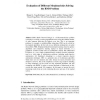Free Online Productivity Tools
i2Speak
i2Symbol
i2OCR
iTex2Img
iWeb2Print
iWeb2Shot
i2Type
iPdf2Split
iPdf2Merge
i2Bopomofo
i2Arabic
i2Style
i2Image
i2PDF
iLatex2Rtf
Sci2ools
EVOW
2007
Springer
2007
Springer
Evaluation of Different Metaheuristics Solving the RND Problem
RND (Radio Network Design) is a Telecommunication problem consisting in covering a certain geographical area by using the smallest number of radio antennas achieving the biggest cover rate. This is an important problem, for example, in mobile/cellular technology. RND can be solved by bio-inspired algorithms. In this work we use different metaheuristics to tackle this problem. PBIL (Population-Based Incremental Learning), based on genetic algorithms and competitive learning (typical in neural networks), is a population evolution model based on probabilistic models. DE (Differential Evolution) is a very simple population-based stochastic function minimizer used in a wide range of optimization problems, including multi-objective optimization. SA (Simulated Annealing) is a classic trajectory descent optimization technique. CHC is a particular class of evolutionary algorithm which does not use mutation and relies instead on incest prevention and disruptive crossover. Due to the complexity o...
Artificial Intelligence | Certain Geographical Area | EVOW 2007 | Population-Based Incremental Learning | Population-based Stochastic Function |
| Added | 16 Aug 2010 |
| Updated | 16 Aug 2010 |
| Type | Conference |
| Year | 2007 |
| Where | EVOW |
| Authors | Miguel A. Vega-Rodríguez, Juan Antonio Gómez Pulido, Enrique Alba, David Vega-Pérez, Silvio Priem-Mendes, Guillermo Molina |
Comments (0)

